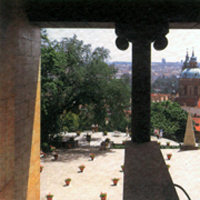
The Castle Gardens, Prague
The International Carlo Scarpa Prize for Gardens
XIII Annual Award, 2002
The jury of the International Carlo Scarpa Prize for Gardens has unanimously decided to award the thirteenth Prize to the Gardens of Prague Castle, the monumental Hrad, which overlooks the city. The gardens are laid out in the narrow spaces between ramparts, walls and the buildings of the castle, which was originally the seat of imperial power and later, from 1918, of the President of the Republic.
The function of these spaces has changed many times over the years, reflecting the complex history of the castle from its foundation in the second half of the xi century and through several destructions and rebuildings in the Romanesque and late-Gothic periods and under the Empress Maria Teresa, through times when it represented absolute dominion, especially during the reigns of Charles IV (1346-1378) and Rudolph II (1576-1611), and others when it symbolized crisis, such as the long and tragic Thirty Years War (1618-1648). Under the Habsburgs extensive transformation work was done to create English-style gardens but they fell inexorably into decline.
The gardens in their present form reflect the wishes of President Tomás Garrigue Masaryk (1850-1937) and the skills of the architect Joze Plecnik (1872-1957), brought together in the framework of a far-reaching project to redefine the role of the castle as a symbol of the country’s newly acquired democracy and of a desire to look forward to a “new Europe”. In the fifteen years between 1920 and 1935 the process led to radical changes in the use of the castle and in access to its inner spaces, its courtyards and its gardens. But the overall project was much bigger in scope: starting from the Belvedere Gardens it proposed new parks and avenues in the northern part of the city and would indeed have affected the entire forma urbis; the larger project was never realized, in part because of resistance in academic circles and amongst the general public; but thanks in large part to the vision and determination of Alice Masarykova, the President’s daughter, this slender space in fifteen years took definitive shape as a place of mediation between castle and city, between auctoritas and civitas.
Work started with the broadly tiered Paradise Garden, the entrance to which is through a small opening in the top of the wall, a carefully calculated point of contact between the inside and the outside, between the long stepped road that scales the hill outside and the sudden surprise of the descent towards the interior. Then came the geometrical lawns and the stone fountain, followed by the long, narrow embankment on the southern side, below the eighteenth century façade added by Maria Teresa, which stretches as far as the easternmost tip of the castle.
Text taken from the 2002 Carlo Scarpa Prize Statement, edited by the Jury.
